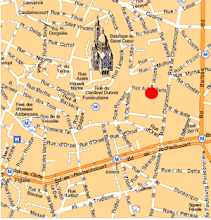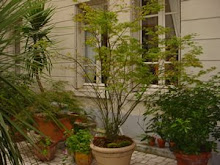 Phil Stine walked a grid pattern with Frank Assazi in search of water with the aid of a Y-shaped willow stick on Mr. Assazi's land in Merced, Calif. (Peter DaSilva for The New York Times)
Phil Stine walked a grid pattern with Frank Assazi in search of water with the aid of a Y-shaped willow stick on Mr. Assazi's land in Merced, Calif. (Peter DaSilva for The New York Times)
California farmers know 'witch' way leads to water
By Jesse McKinley
Thursday, October 9, 2008
WATERFORD, California: Phil Stine is not crazy, or possessed, or even that special, he says. He has no idea how he does what he does. From most accounts, he does it very well.
"Phil finds the water," said Frank Assali, an almond farmer and convert. "No doubt about it."
Stine is a "water witch," one of a small band of believers for whom the ancient art of dowsing is alive and well.
Emphasis, of course, on well. Using nothing more than a Y-shaped willow stick, Stine has as his primary function determining where farmers should drill to slake their crops' thirst, adding an element of the mystical to a business in which the day-to-day can often be painfully plain.
Asked how he does it, Stine has a standard retort. "I just tell people," Stine said, "it's the amount of lead" in your haunches.
Scientists pooh-pooh dowsers like Stine, saying their abilities are roughly on par with a roll of the dice. But water witches have been much in demand of late in rural California, the nation's biggest agricultural engine, struggling through its second year of drought.
The dry period has resulted in farm layoffs, restrictions on residential and agricultural water use, and hard times for all manner of ancillary businesses, like tractor dealerships and roadside diners.
"There is a domino effect to the point that a little clothing store goes out of business in a town, because the people living there move on," said Doug Mosebar, the president of the California Farm Bureau.
The state estimates nearly $260 million in crop damages through August. The drought has been particularly hard on areas like the Central Valley - the state's farming basin, some 400 miles, or 640 kilometers, long - and in Southern California, where some avocado farmers have taken to stumping their trees, cutting them back to the base rather than watering them.
Statewide, farmers have left nearly 80,000 acres, or 32,374 hectares, fallow rather than struggle - and pay - to keep them irrigated.
The dry times have meant good business for people like Blake Hennings, a well driller in the Central Valley city of Turlock, who says he has a lengthy waiting list and a yard full of worn-down drill bits. At a recent job he dug five test holes, all of which had been identified by a water witch like Stine.
"We only had one bad one," said Hennings, whose brother Curtis also dabbles with the dowser. "How they do it is beyond me."
How many rural witches are still around is an open question. Water witches have no trade unions - or covens. Few advertise, or dowse full time.
Stine, for example, offers his services without charge, though he says he does accept thanks of another sort. "I got a bunch of gift certificates," he said.
Dowsers have been part of lore for millenniums, and many on the farm today have no doubt that they have special abilities. Richard Cotta, the chief executive of California Dairies, a Central Valley cooperative, said he vividly remembered the first time he saw a witch.
"I was 6 years old," Cotta recalled. "A neighbor's well had gone dry, and this old fellow came out and he witched it, quite a ways away from the other well. Doggone it, I'll be darned if they didn't get water. That made a believer out of me." So much of a believer that Cotta recently walked away from a land deal because Stine said there was no water.
"He said he couldn't find enough water to do what we wanted," Cotta said.
Thomas Harter, a hydrologist at the University of California, Davis, who runs workshops with farmers looking to drill wells, says there is no scientific evidence that dowsers have special talent at finding water. They are, however, usually much cheaper than the various scientific tools, like electromagnetic imaging or seismic studies, that can help find aquifers.
"It's worth a bottle of whiskey to have a guy come out," Harter said.
But Harter also says men like Stine, who worked in the irrigation business for nearly half a century, could have an intuitive sense of where water is, simply by dint of knowing the territory.
In the Central Valley, which was once the bottom of a giant inland lake that water soaked into for eons, finding groundwater for domestic use is pretty easy, Harter says. But Stine's efforts are reserved for agricultural wells, which need to produce much more water and sometimes can run 1,000 feet, or 305 meters, deep.
Stine is 77 and retired from a successful irrigation business here in Waterford, a town of about 7,000 on the banks of a slender section of the Tuolumne River, the same river from which he now cuts his willow branches.
What does he look for in a good dowsing rod? "It's got to have leaves on it, and it can't really be bigger than your finger," Stine said. "And you got to find one with a fork in it."
He says he was taught his dark arts many years back by a fellow irrigator who used a metal coat hanger and a hard hat to dowse.
"He used a metal rod and wore a metal hat, and that thing would hit his head," Stine said. "So he always wore that hat."
The American Society of Dowsers, an organization based in Vermont, claims more than 3,000 members who use various tools - pendulums, L-shaped rods, bobbers - on all manner of mystery, finding minerals and lost objects, and even attaining "ancient wisdom," according to the group's Web site.
"Dowsing is a system that uses tools," said George Weller, the society's national president. "And the tools give you an answer."
Stine, a plainspoken Baptist, claims no connection with a higher power or otherworldly sensations when dowsing, merely a strong tugging in the hands.
"You can feel it twist," he said. "You can't hang on to it. It will actually break in your hand."
On an afternoon not long ago, Stine was summoned to a parched patch of earth outside Merced, California, owned by Assali and Cotta.
Stine's process is simple: walk the eastern edge of the property with the willow held straight up. When it bends toward him, he marks the spot with a flag and keeps walking. If he gets two or three in quick succession, he is convinced there is a stream underfoot.
On Assali's and Cotta's land, Stine worked fast, practically speed-walking. And then, after about 150 feet, the willow bowed suddenly - inexplicably - toward Stine's chest.
"There it goes," he said, his hands straining against the stick.
And so it went, again and again as Stine moved along the property's perimeter, planting perhaps 20 flags. Assali said he would start drilling on Stine's recommendation as soon as he could.

A Place in the Auvergne
A Place in My Country
Ian Walthew
Farm Blogs
Ranch Blogs
Rural Blogs
Countryside Blogs
Smallholding Blogs
Urban Homesteading Blogs
Homesteading Blogs
Homestead Blogs
Allotment Blogs
Apiculture Blogs
Bee-keeping Blogs
Auvergne
Auvergnate
Auvergnat
Auvergnats
France
Rural France
Blogs about France
Paris / Montmartre/ Abbesses holiday / vacation furnished apartment rental





















No comments:
Post a Comment